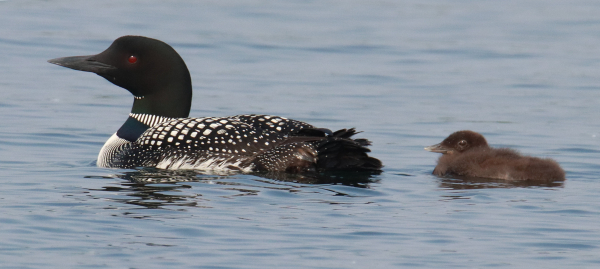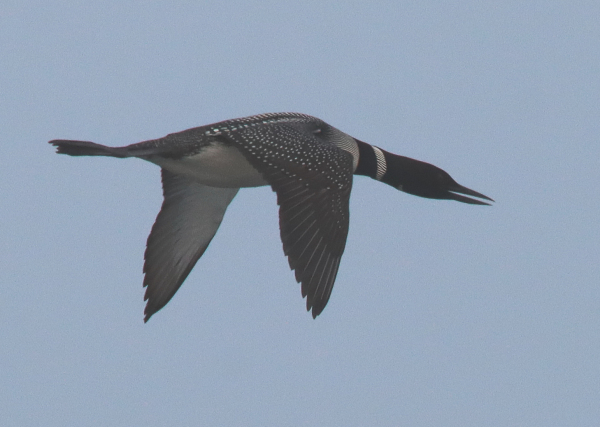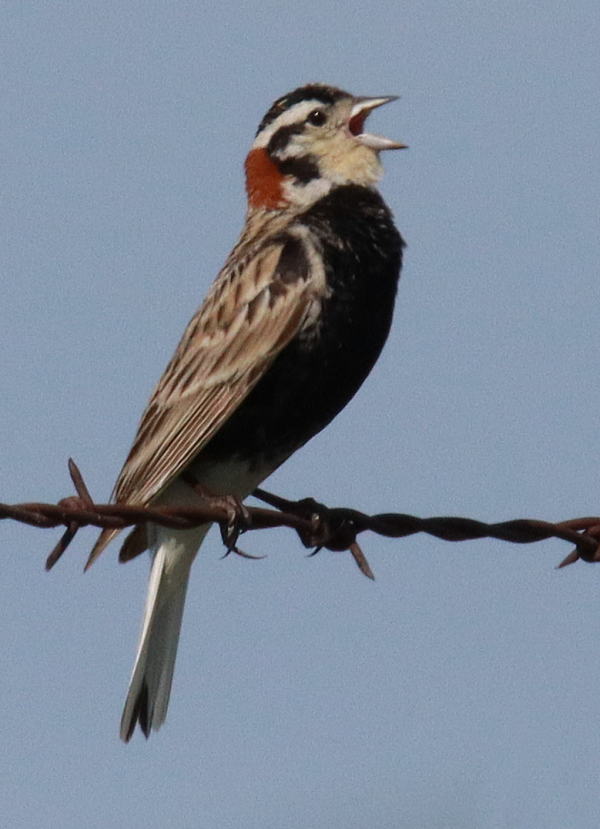
A seemingly inactive Bald Eagle suddenly caught sight of something that led it to lean forward and scream loudly, providing a very unexpected and exciting action photo.

The return trip to Minnesota lakes country provided a number of photo opportunities under blue sky conditions. This adult Common Loon with 1 of its 2 new hatchlings were among 11 loons observed and photographed last Wednesday.

It’s pretty rare to see a loon flying in that area, but having the chance to photograph one has been a fleeting wish.

A Sunday afternoon birding drive to an area traditionally inhabited by territorial Chestnut-sided Longspurs provided the opportunity to photograph a singing male.

Red-necked Grebes are uncommon in the region, but during recent years a couple pairs have nested at a few deeper lakes south of The Birding Wire office.
|
The surprise of the “early” new hatchlings with a pair of Common Loons the previous week had me wishing for good weather to make a return trip to west-central Minnesota. Wednesday’s weather looked like the best bet as I monitored weather predictions, and with Andy’s shared enthusiasm for another photo trip I hit the road for an encore effort. There was no way we could have ordered a better afternoon on the water, and after some unusual interactions with a pair of loons, then a single loon, we found 2 more new families of Common Loons on Pelican Lake.
The first pair of loons we encountered behaved in a rather unusual way, diving for long periods, and remaining half-submerged when they surfaced, so after a few photo attempts we decided to move on. We checked the east side of Pelican Lake, where we observed the pair with “twin” hatchlings 6 days earlier, but there was no sign of loons or other waterbirds as we cruised along the east and northeast shoreline. We decided to head south to a bay where there is an artificial nesting structure that was used by Bald Eagles last summer, and on the way, we found a single Common Loon closer to the middle of the lake, but this one turned out to be even more secretive, diving for even longer periods across broad swaths of water, so we left him behind too.
Just as the eagle and Osprey nesting structure came into view, which appeared to be unused this season, we sighted a pair of loons with 2 newly hatched downy young in a shallow area that took some maneuvering on Andy’s part as skipper. As we floated into position, the adults were in the midst of something of a feeding frenzy, diving just below or near the 2 hatchlings and quickly returning with a very small fish or a large aquatic mayfly larvae. The photo action was very quick and interesting as I tried to take photos when 2 to 4 loons were all facing in a pleasing direction in the afternoon sunlight. Andy became quite relaxed as he melted into a lounger and appreciated how relaxing it could be to float quietly on glassy water at the edge of a wooded area with a shallow wetland and vast lake beyond that, with a silence broken only by the sound of singing birds.
Just then an adult Common Loon caught my eye as it flew above the treetops. I quickly reacted by attempting a couple photographs as it passed by. We rarely get to see flying loons, and it’s much rarer to be in position to photograph a loon in flight, so I made the most of the momentary opportunity. By that time, the loon family slowed their activity level as and the hatchlings appeared to be more interested in napping than eating. Only the male was on the hunt now, although the downy hatchlings came back to life each time the male returned with food.
As the female began preening, I took a few “family portraits,” and we headed back toward Andy’s home. When I least expected it, Andy looked over my shoulder to point out a distant bonus adult loon leading a newly hatched pair of “twins” toward the far shore. They were positioned near the middle of the lake, within sight of where we saw the first family group the week before. But these hatchlings were too young to be the same downy loons we discovered June 5th – this was a third family group.
The loons were positioned in the midst of some of the most beautifully colored water, reflected from the clear blue sky, and the windless late afternoon produced a glassy calm lake surface that added a memorable ambiance infused into the loon scene before us. The loons melded into the lake scene produced some exceptional photographs via my camera and lens from the loon pontoon.
During this birding cruise we also observed several Great Blue Herons, a pair of Wood Ducks, Mallards (mostly males [females were likely incubating eggs]), Cliff Swallows, Tree Swallows, and in Andy’s yard, Gray Catbirds, American Robins, a male Yellow Warbler, and a surprise thrush that I would call a Swainson’s Thrush, although they should have be much farther north by June 11th. I thanked Andy for a great time again and headed for home – I still had 200 miles of driving ahead of me. But not so quick, there were occasional Eastern Bluebirds perched along the way north, and there was a pair of Trumpeter Swans resting on the shore of a marsh with 4 downy cygnets.
Even so, it was an adult Bald Eagle that forced me to stop, even though it was just another bird perched on a post (ha). I focused on the magnificent raptor, which didn’t show much character; but a few moments later, something behind me definitely caught its attention. Potential prey? It actually seemed more like it might be another Bald Eagle or an Osprey, although I felt that I couldn’t turn to see what its point of interest was without missing some eagle action. Indeed, the big Bald leaned forward, turned its head and Screamed as I took 3 rapid-fire photos! WoW, how exciting! The action was unexpected and the level of intensity from the eagle provided a memorable photo to share with you here.
Local Nesting Birds
It’s been a slight letdown since the exciting surprises of spring migration have passed. The seemingly daily sightings of unexpected birds created a level of excitement and, to a degree, expectations that dissipated and vanished the first week of June. But soon after that initial feeling of loss, there was another dimension that began to expand – nesting birds, including some migrant songbirds like Yellow Warblers and Orchard Orioles, Common Yellowthroats, Bobolinks, Western Meadowlarks, Horned Larks, Brown Thrashers, American Robins, Yellow-headed Blackbirds, Red-winged Blackbirds, Brown-headed Cowbirds, and native sparrows too, especially Grasshopper, Clay-colored, Song, and Savannah Sparrows. Other nesting birds include Red-headed Woodpeckers, Tree Swallows, Least Flycatchers, Western Kingbirds, Eastern Kingbirds, and Mourning Doves,
Add to that group Ring-necked Pheasants, Sharp-tailed Grouse, Common Nighthawks, Black Terns, Common Terns, Wilson’s Snipe, American Avocets, Marbled Godwits, Willets, Wilson’s Phalaropes, Killdeer, and American Bitterns. There were also 4 species of grebes – Western, Pied-billed, Eared, and Red-necked Grebes – and colonial nesting birds that feed in the area too: White Pelicans, White-faced Ibis, a few Great Egrets and Great Blue Herons, Black-crowned Night Herons, Double-crested Cormorants, Ring-billed Gulls, and Franklin’s Gulls. And there are the waterfowl – Giant Canada Geese and the many species of ducks! Raptors have been surprisingly rare lately, with few Swainson’s Hawks, Red-tailed Hawks, and Northern Harriers in the area.
It’s been great fun to check on favorite birding locations and the drives between them, and when I witnessed a pair of Red-necked Grebes building a nest near one of my regular photo areas – in a small bay on the edge of White Lake – it was representative of when I began to appreciate the transition to summer more. There was also more concrete evidence of successful nesting this week that included the first brood of Ring-necked Pheasants 2 miles south of home last Friday, another Mallard brood Friday, a trio of Willet hatchlings were foraging with adults too, and at least 1 downy Marbled Godwit was in the company of an adult pair Sunday. A newly hatched duo of Western Grebes were seen riding on the back of an adult just 4 miles south Monday afternoon, and many more broods will follow soon!
Birding at Home
On a rainy Thursday, an exciting new feeder visitor was a yearling male Orchard Oriole with new looking plumage that made him especially attractive and a potential photo subject. He actually appeared with an adult male, both perching on the circus jelly feeder at the same time; and female and male Orchard Orioles continue to be regulars. No less surprising or exciting was the gloomy Saturday appearance of a beautiful bright orange-and-black male Baltimore Oriole that checked out the feeding station and jelly feeder, singing a couple times before leaving. I thought the chance of seeing new Baltimore Orioles had slipped away before June 14th, but there he was, his color very distinct from the identifiable ‘yellow-orange’-and-black male Baltimore Oriole who is a regular visitor most days, as are American Robins, Gray Catbirds, and House Finches.
It was especially nice to see a new robin fledgling follow an adult to perch on a sumac branch next to my feeding station, where the adult collected jelly and fed the begging young one. That episode played out again Monday, and Sunday an older fledgling robin perched at one of the jelly feeders on its own, perhaps attracted by the avian action. There was also a fledgling House Finch at my feeding station last Thursday, and the trend of fledglings showing up is one that I hope will continue with orioles and maybe even hummingbirds to follow.
Speaking of hummingbirds, last Tuesday evening, after publishing the latest issue of The Birding Wire, a beautifully large and obvious female Ruby-throated Hummingbird appeared outside my bay windows, first checking for small insects at my feeding station, then flying up to each window to hover and look for bugs there. She checked out the flowers, but clearly wasn’t interested in nectar – just bugs. Later, however, the same large female did stop for nectar at my feeder a few times, as did a really nice male who flashed his red gorget to spray color in my direction. How I wished they would call my yard and neighborhood their own!
There was a bit of a hummingbird vacancy thereafter, until Sunday when a smaller female fed on nectar at my feeder, and Monday was apparently reserved only for a male Ruby-throat that tasted the nectar a few times but seemed to be concentrating on catching bugs among the vegetation. Friday is the first day of summer, so plan on some celebratory birding over the weekend, on your own or with family or friends.
Article and Photos by Paul Konrad
Share your bird sightings and photographs at editorstbw2@gmail.com